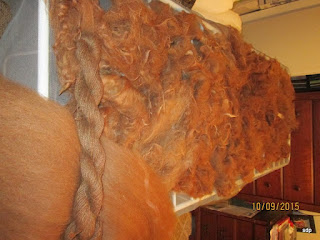My contribution was to conduct a mordant guidance lesson at a guild meeting a couple of meetings ago, so that everyone who wanted to attend could prepare their yarns suitably prior to the day. That worked well and we then posted out the e-copy of the handouts to everyone so that if they signed up to attend they had the instructions too. Which it could be noted was a cunning way to avoid having to hear me drone on for an hour about all aspects of mordanting...
I also compiled a few fact sheets for the various dyes that were finally chosen for the day. Facts including their various names, where they grow, what results are likely (cotton and wool were the main focus), based on the use of alum as a mordant, the procedure and cleanup afterwards.
I brought the indigo dye pot and another guild member contributed a walnut dye ready to go.
The more active part of the 'dye committee' managed to pull together 4 dyes: barberry, blackberry, iris, and coreopsis and pots, buckets, samples, burners, rinse buckets, after dye dips of vinegar, baking soda, and copper plus a whole lot of wool and cotton samples
 |
| 4 of the dyes, walnut and indigo out of picture. |
 |
| Indigo pot looking good prior to dyeing. |
 |
| The various colours achieved. |
While I was getting the ingredients ready for the indigo pot I discovered 4 oz of madder that I had forgotten I had. I'll have to try that soon. My dye efforts were only a sample skein of handspun alpaca (from NZ) each of walnut and indigo. Both turned out lighter than commercial spun wool, but both have a much nicer sheen to them.
Everyone washed and hung their various dyed materials and we all sat down for a shared lunch. Plans are afoot for next year...











